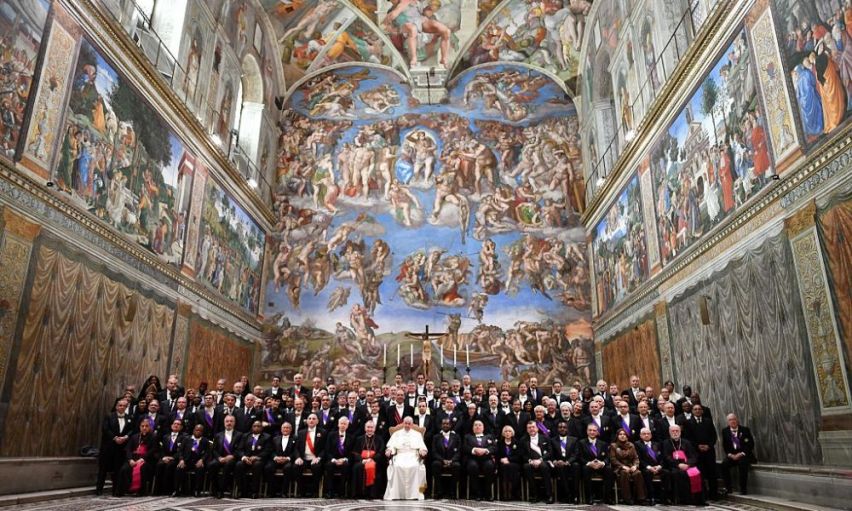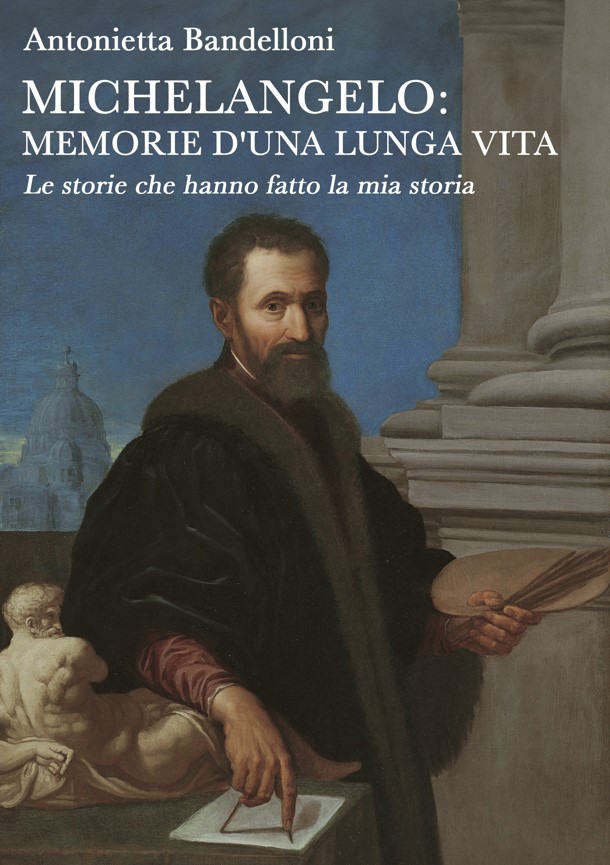Problemi di stabilità per la Cappella Sistina
Sapete, la Cappella Sistina, prima della edificazione dei contrafforti tutt’ora esistenti, ebbe non pochi problemi di stabilità. Fu edificata sopra un terreno cedevole e questo ha provocato cospicui danni nel corso dei secoli.
Era il 15 maggio del 1504 quando la parete meridionale si inclinò verso l’interno causando una enorme frattura nella volta. Il cielo di lapislazzuli trapuntato di stelle di Pier Matteo d’Amelia risultò fortemente danneggiato.
La Sistina venne dichiarata inagibile e tornò ad accogliere le funzioni sacre solo dopo che il soffitto dei locali soprastanti vennero ancorati alle pareti mediante l’uso di catene di ferro. Qualche anno dopo Giulio II decise di affidare a me la nuova decorazione della volta che ancora oggi potete vedere con i vostri occhi.

Il giorno di Natale del lontano 1522, senza dare alcun preavviso, l’architrave posto all’ingresso crollò mettendo tutti i presenti in allarme.
Papa Adriano VI era da poco passato lì sotto e per un soffio non ci rimise l’osso del collo. Ebbe la peggio una guardia svizzera che era di picchetto all’entrata: non ci fu niente da fare, morì sul colpo. Immaginatevi il trambusto che si creò mentre il pontefice era intento a celebrare la solenne messa del 25 dicembre.
I guai non finirono con quell’episodio tragico. Mentre era in pieno svolgimento il conclave del 1523, indetto per sostituire il breve pontificato di papa Adriano VI, la Cappella Sistina ebbe di nuovo degli importanti cedimenti e fu evidente che bisognava intervenire al più presto per rinforzare la struttura dell’edificio. Venne chiamato Antonio da Sangallo ma lui sminuì il pericolo lasciando correre.

Solo tre anni dopo, l’architrave posizionato sulla porta che apre sulla Sala Regia, cadde fragorosamente rovinando la parte bassa degli affreschi del Ghirlandaio e del Signorelli. Le parti mancanti di quei preziosi lavori furono poi rifatte da Matteo da Lecce e Hendrick van der Broeck nel 1535.
Il tetto della Sistina non era un gran che… me ne accorsi anch’io: c’erano delle spaventose infiltrazioni d’acqua. In seguito a un incendio il tetto fu ricostruito in breve tempo e almeno quel problema fu in parte risolto magistralmente.

Se pensate che i problemi fossero finiti lì, siete in errore. Durante il conclave del 1565 che porterà all’elezione sul soglio di Pietro papa Pio V, si aprirono delle grandi crepe sulla volta. In via eccezionale i cardinali consentirono a tre architetti di avere accesso alla Sistina durante il conclave: erano il Vignola, il Salustio e Nanni di Baccio.
Si misero al lavoro per far consolidare il terreno con zeppe di travertino e ben cinque pilastri sotterranei. Poco dopo vennero edificati i contrafforti in mattoni sul lato sud e nord della Cappella.

Da allora la Sistina è rimasta al suo posto, senza cedimenti. Grazie a quei contrafforti ancora oggi, 5milioni di visitatori all’anno, hanno la possibilità di ammirare i capolavori quattrocenteschi e quelli miei presenti nella Cappella Sistina.
Il sempre vostro Michelangelo Buonarroti e i suoi racconti quotidiani, o quasi
Stability problems for the Sistine Chapel
You know, the Sistine Chapel, before the construction of the still existing buttresses, had many stability problems. It was built on soft ground and this has caused considerable damage over the centuries.
It was May 15, 1504 when the southern wall tilted inwards causing a huge fracture in the vault. Pier Matteo d’Amelia’s star-studded lapis lazuli sky was severely damaged. The Sistine Chapel was declared unfit for use and returned to host sacred functions only after the ceiling of the rooms above were anchored to the walls using iron chains. A few years later Julius II decided to entrust me with the new decoration of the vault that you can still see with your own eyes today.
On Christmas day in 1522, without giving any warning, the architrave at the entrance collapsed, alarming everyone present. Pope Adrian VI had just passed under there and by a whisker he didn’t lose his neck. A Swiss guard who was on guard duty at the entrance had the worst: there was nothing they could do, he died on the spot. Imagine the hustle and bustle that arose while the pontiff was intent on celebrating the solemn mass on December 25th.
The troubles did not end with that tragic episode. While the conclave of 1523, called to replace the brief pontificate of Pope Adrian VI, was in full swing, the Sistine Chapel again suffered major sagging and it was clear that it was necessary to intervene as soon as possible to reinforce the structure of the building. Antonio da Sangallo was called but he minimized the danger by letting it go.
Only three years later, the architrave positioned on the door that opens onto the Sala Regia fell with a crash, ruining the lower part of the frescoes by Ghirlandaio and Signorelli. The missing parts of those precious works were then redone by Matteo da Lecce and Hendrick van der Broeck in 1535.
The roof of the Sistine Chapel wasn’t that great… I noticed it too: there were appalling water infiltrations. Following a fire, the roof was rebuilt in a short time and at least that problem was partially solved masterfully.
If you think that’s where the trouble ended, you’re wrong. During the conclave of 1565 which will lead to the election of Pope Pius V to the throne of Peter, large cracks opened up on the vault. Exceptionally, the cardinals allowed three architects to have access to the Sistine Chapel during the conclave: they were Vignola, Salustio and Nanni di Baccio. They set to work to consolidate the ground with travertine wedges and as many as five underground pillars. Shortly afterwards the brick buttresses were built on the south and north sides of the Chapel. Since then the Sistine has remained in place, without sagging. Thanks to those buttresses still today, 5 million visitors a year have the opportunity to admire the fifteenth-century masterpieces and those of mine in the Sistine Chapel.
Your always Michelangelo Buonarroti and the daily stories of him, or almost

Sostienici – Support Us
Se questo blog ti piace e ti appassiona, puoi aiutarci a farlo crescere sempre più sostenendoci in modo concreto condividendo i post, seguendo le pagine social e con un contributo che ci aiuta ad andare avanti con il nostro lavoro di divulgazione. . ENGLISH: If you like and are passionate about this blog, you can help us make it grow more and more by supporting us in a concrete way by sharing posts, following social pages and with a contribution that helps us to move forward with our dissemination work.
5,00 €












1 commento »